Importance of ASA 701 in Auditing: Analysis of Energy Industry in Australia
VerifiedAdded on 2023/01/10
|14
|3158
|69
AI Summary
This assignment analyzes the importance of ASA 701 in auditing and its impact on the energy industry in Australia. It focuses on two major companies in the industry and examines their audit reports.
Contribute Materials
Your contribution can guide someone’s learning journey. Share your
documents today.

Secure Best Marks with AI Grader
Need help grading? Try our AI Grader for instant feedback on your assignments.

By student name
Professor
University
Date: 14th May, 2019.
Page 1
Professor
University
Date: 14th May, 2019.
Page 1

Executive Summary
The following assignment is based on a very important auditing standard ASA 701
Communicating Key Audit Matters in the Independent Auditor Report. It highlights
the importance of this standard to the user of the financial statements and the
auditors.The following assignment is based on the Energy industry of Australia and
two important companies of that sector are analyzed based on their annual report.
Page 2
The following assignment is based on a very important auditing standard ASA 701
Communicating Key Audit Matters in the Independent Auditor Report. It highlights
the importance of this standard to the user of the financial statements and the
auditors.The following assignment is based on the Energy industry of Australia and
two important companies of that sector are analyzed based on their annual report.
Page 2
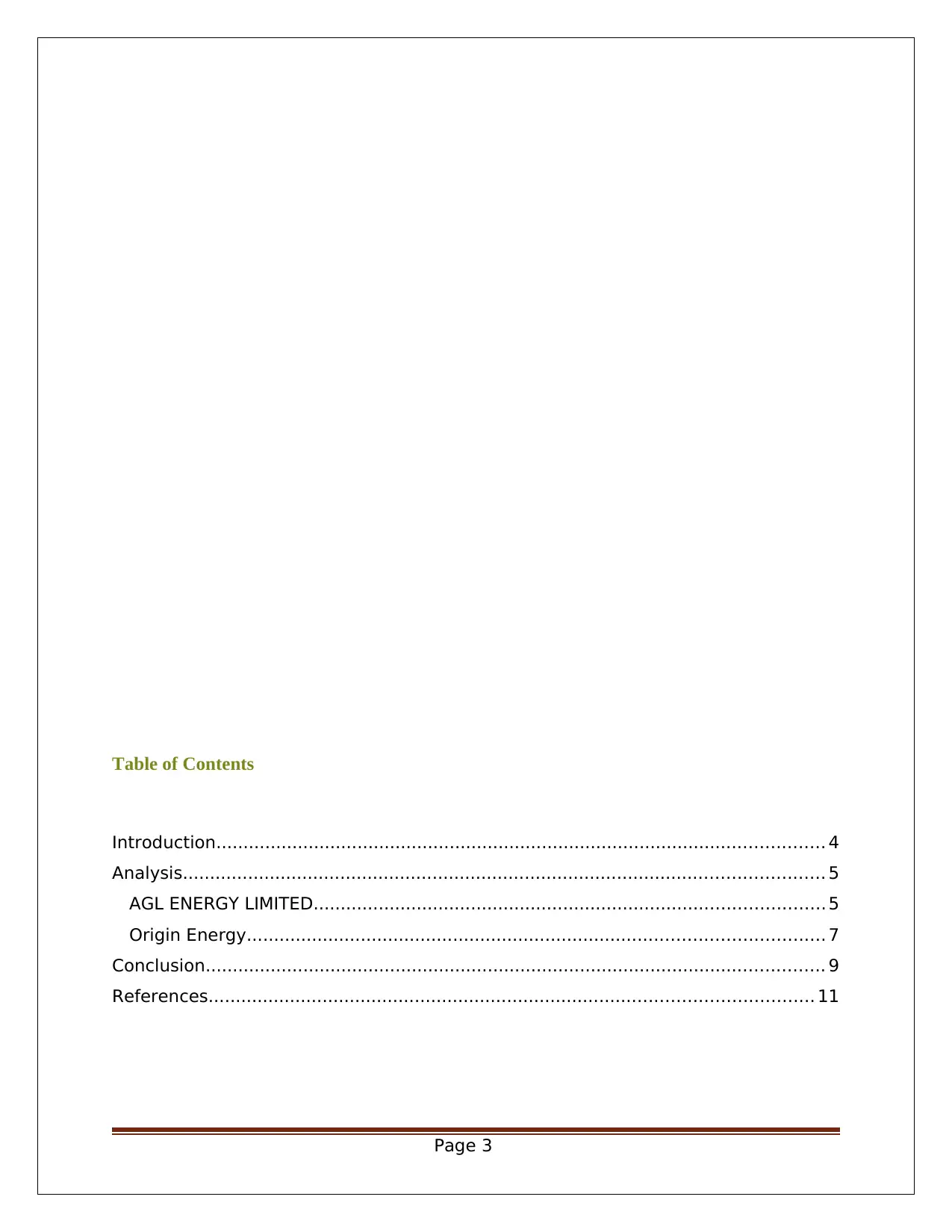
Table of Contents
Introduction................................................................................................................ 4
Analysis...................................................................................................................... 5
AGL ENERGY LIMITED.............................................................................................. 5
Origin Energy.......................................................................................................... 7
Conclusion.................................................................................................................. 9
References............................................................................................................... 11
Page 3
Introduction................................................................................................................ 4
Analysis...................................................................................................................... 5
AGL ENERGY LIMITED.............................................................................................. 5
Origin Energy.......................................................................................................... 7
Conclusion.................................................................................................................. 9
References............................................................................................................... 11
Page 3
Secure Best Marks with AI Grader
Need help grading? Try our AI Grader for instant feedback on your assignments.
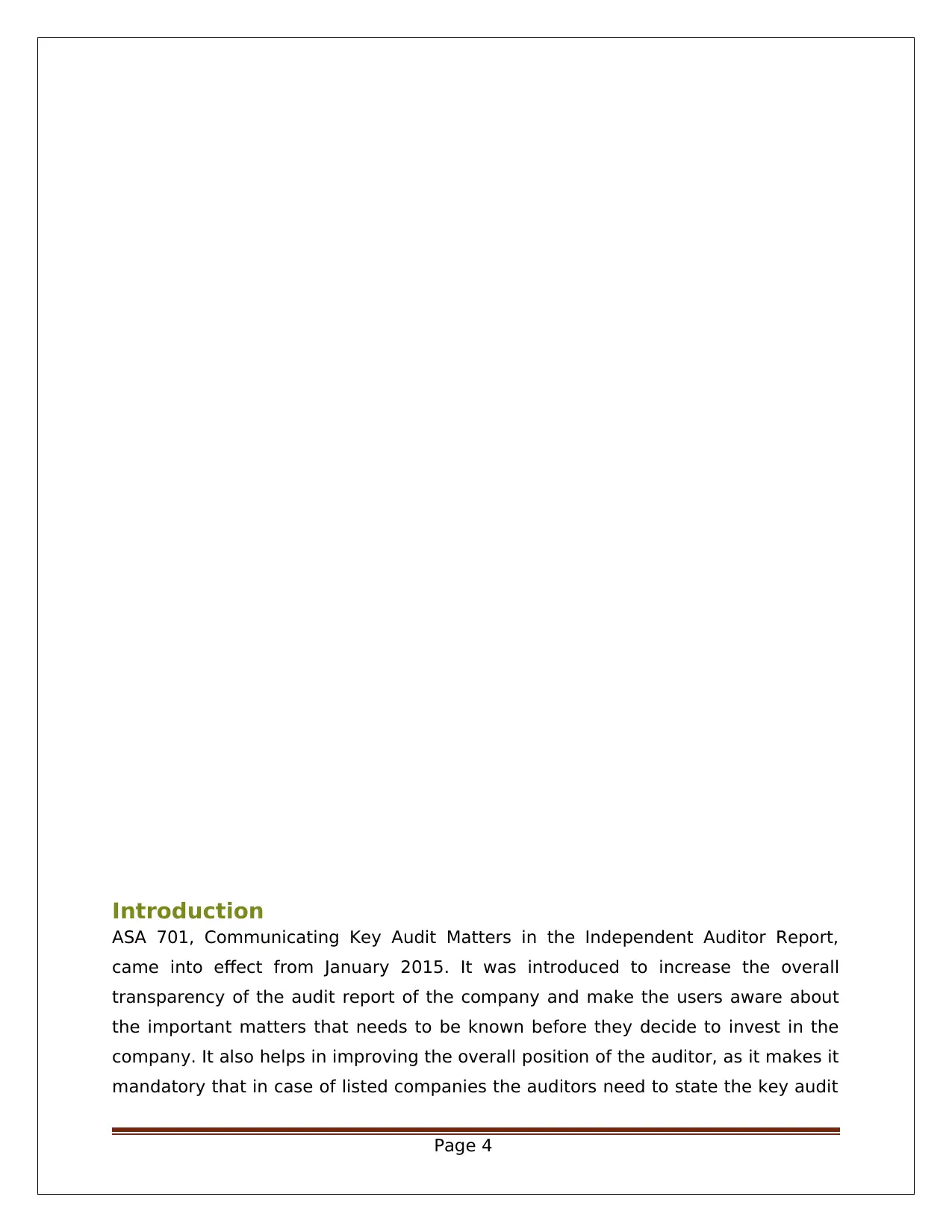
Introduction
ASA 701, Communicating Key Audit Matters in the Independent Auditor Report,
came into effect from January 2015. It was introduced to increase the overall
transparency of the audit report of the company and make the users aware about
the important matters that needs to be known before they decide to invest in the
company. It also helps in improving the overall position of the auditor, as it makes it
mandatory that in case of listed companies the auditors need to state the key audit
Page 4
ASA 701, Communicating Key Audit Matters in the Independent Auditor Report,
came into effect from January 2015. It was introduced to increase the overall
transparency of the audit report of the company and make the users aware about
the important matters that needs to be known before they decide to invest in the
company. It also helps in improving the overall position of the auditor, as it makes it
mandatory that in case of listed companies the auditors need to state the key audit
Page 4
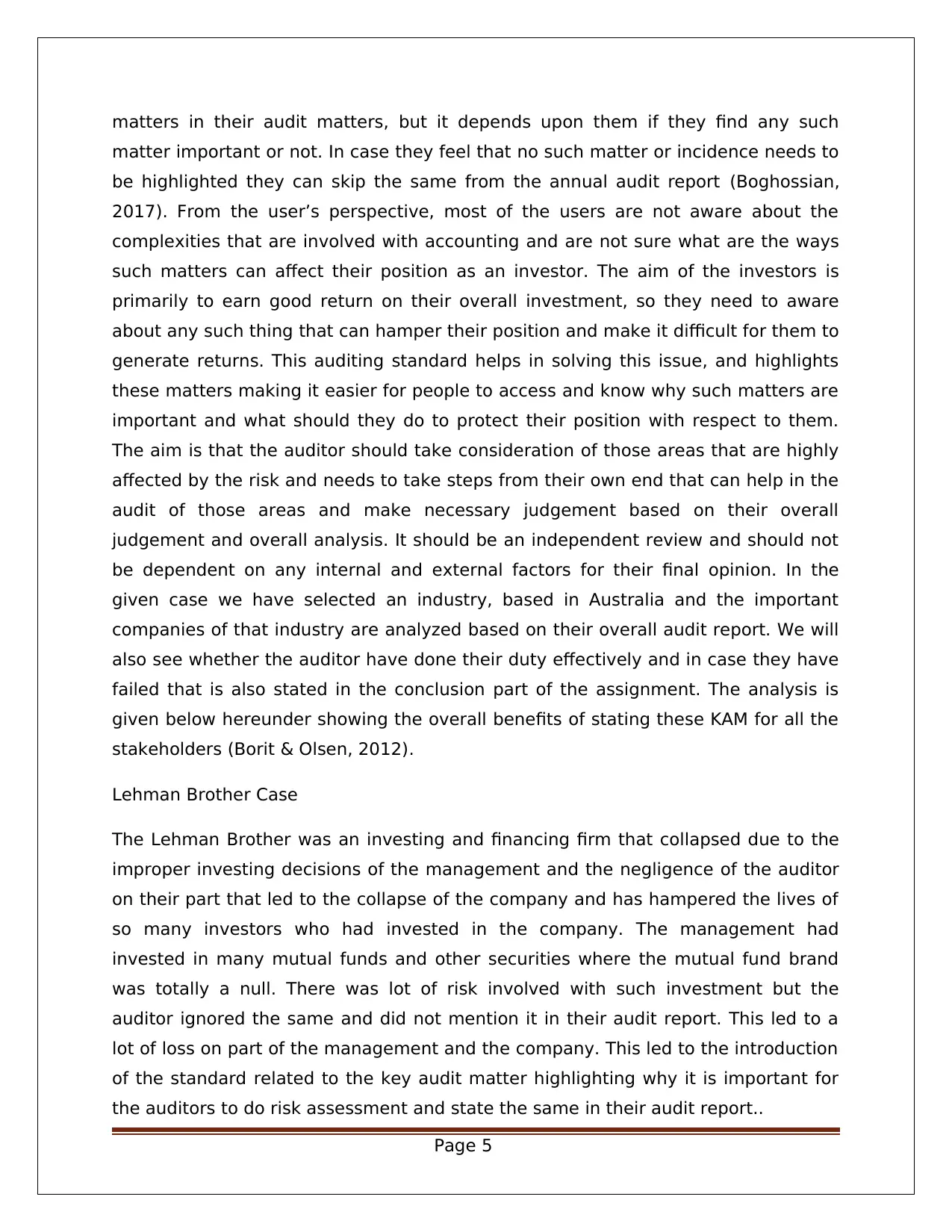
matters in their audit matters, but it depends upon them if they find any such
matter important or not. In case they feel that no such matter or incidence needs to
be highlighted they can skip the same from the annual audit report (Boghossian,
2017). From the user’s perspective, most of the users are not aware about the
complexities that are involved with accounting and are not sure what are the ways
such matters can affect their position as an investor. The aim of the investors is
primarily to earn good return on their overall investment, so they need to aware
about any such thing that can hamper their position and make it difficult for them to
generate returns. This auditing standard helps in solving this issue, and highlights
these matters making it easier for people to access and know why such matters are
important and what should they do to protect their position with respect to them.
The aim is that the auditor should take consideration of those areas that are highly
affected by the risk and needs to take steps from their own end that can help in the
audit of those areas and make necessary judgement based on their overall
judgement and overall analysis. It should be an independent review and should not
be dependent on any internal and external factors for their final opinion. In the
given case we have selected an industry, based in Australia and the important
companies of that industry are analyzed based on their overall audit report. We will
also see whether the auditor have done their duty effectively and in case they have
failed that is also stated in the conclusion part of the assignment. The analysis is
given below hereunder showing the overall benefits of stating these KAM for all the
stakeholders (Borit & Olsen, 2012).
Lehman Brother Case
The Lehman Brother was an investing and financing firm that collapsed due to the
improper investing decisions of the management and the negligence of the auditor
on their part that led to the collapse of the company and has hampered the lives of
so many investors who had invested in the company. The management had
invested in many mutual funds and other securities where the mutual fund brand
was totally a null. There was lot of risk involved with such investment but the
auditor ignored the same and did not mention it in their audit report. This led to a
lot of loss on part of the management and the company. This led to the introduction
of the standard related to the key audit matter highlighting why it is important for
the auditors to do risk assessment and state the same in their audit report..
Page 5
matter important or not. In case they feel that no such matter or incidence needs to
be highlighted they can skip the same from the annual audit report (Boghossian,
2017). From the user’s perspective, most of the users are not aware about the
complexities that are involved with accounting and are not sure what are the ways
such matters can affect their position as an investor. The aim of the investors is
primarily to earn good return on their overall investment, so they need to aware
about any such thing that can hamper their position and make it difficult for them to
generate returns. This auditing standard helps in solving this issue, and highlights
these matters making it easier for people to access and know why such matters are
important and what should they do to protect their position with respect to them.
The aim is that the auditor should take consideration of those areas that are highly
affected by the risk and needs to take steps from their own end that can help in the
audit of those areas and make necessary judgement based on their overall
judgement and overall analysis. It should be an independent review and should not
be dependent on any internal and external factors for their final opinion. In the
given case we have selected an industry, based in Australia and the important
companies of that industry are analyzed based on their overall audit report. We will
also see whether the auditor have done their duty effectively and in case they have
failed that is also stated in the conclusion part of the assignment. The analysis is
given below hereunder showing the overall benefits of stating these KAM for all the
stakeholders (Borit & Olsen, 2012).
Lehman Brother Case
The Lehman Brother was an investing and financing firm that collapsed due to the
improper investing decisions of the management and the negligence of the auditor
on their part that led to the collapse of the company and has hampered the lives of
so many investors who had invested in the company. The management had
invested in many mutual funds and other securities where the mutual fund brand
was totally a null. There was lot of risk involved with such investment but the
auditor ignored the same and did not mention it in their audit report. This led to a
lot of loss on part of the management and the company. This led to the introduction
of the standard related to the key audit matter highlighting why it is important for
the auditors to do risk assessment and state the same in their audit report..
Page 5
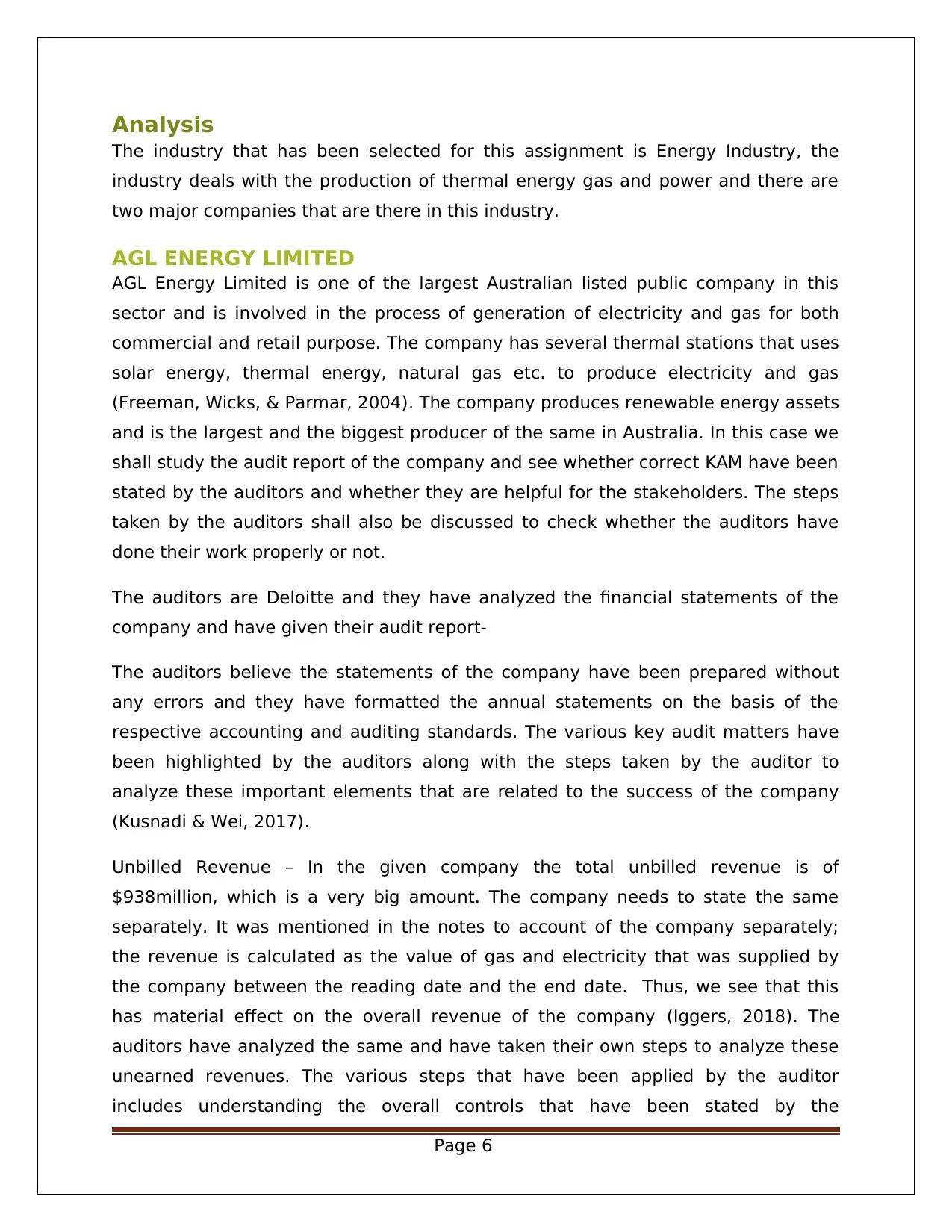
Analysis
The industry that has been selected for this assignment is Energy Industry, the
industry deals with the production of thermal energy gas and power and there are
two major companies that are there in this industry.
AGL ENERGY LIMITED
AGL Energy Limited is one of the largest Australian listed public company in this
sector and is involved in the process of generation of electricity and gas for both
commercial and retail purpose. The company has several thermal stations that uses
solar energy, thermal energy, natural gas etc. to produce electricity and gas
(Freeman, Wicks, & Parmar, 2004). The company produces renewable energy assets
and is the largest and the biggest producer of the same in Australia. In this case we
shall study the audit report of the company and see whether correct KAM have been
stated by the auditors and whether they are helpful for the stakeholders. The steps
taken by the auditors shall also be discussed to check whether the auditors have
done their work properly or not.
The auditors are Deloitte and they have analyzed the financial statements of the
company and have given their audit report-
The auditors believe the statements of the company have been prepared without
any errors and they have formatted the annual statements on the basis of the
respective accounting and auditing standards. The various key audit matters have
been highlighted by the auditors along with the steps taken by the auditor to
analyze these important elements that are related to the success of the company
(Kusnadi & Wei, 2017).
Unbilled Revenue – In the given company the total unbilled revenue is of
$938million, which is a very big amount. The company needs to state the same
separately. It was mentioned in the notes to account of the company separately;
the revenue is calculated as the value of gas and electricity that was supplied by
the company between the reading date and the end date. Thus, we see that this
has material effect on the overall revenue of the company (Iggers, 2018). The
auditors have analyzed the same and have taken their own steps to analyze these
unearned revenues. The various steps that have been applied by the auditor
includes understanding the overall controls that have been stated by the
Page 6
The industry that has been selected for this assignment is Energy Industry, the
industry deals with the production of thermal energy gas and power and there are
two major companies that are there in this industry.
AGL ENERGY LIMITED
AGL Energy Limited is one of the largest Australian listed public company in this
sector and is involved in the process of generation of electricity and gas for both
commercial and retail purpose. The company has several thermal stations that uses
solar energy, thermal energy, natural gas etc. to produce electricity and gas
(Freeman, Wicks, & Parmar, 2004). The company produces renewable energy assets
and is the largest and the biggest producer of the same in Australia. In this case we
shall study the audit report of the company and see whether correct KAM have been
stated by the auditors and whether they are helpful for the stakeholders. The steps
taken by the auditors shall also be discussed to check whether the auditors have
done their work properly or not.
The auditors are Deloitte and they have analyzed the financial statements of the
company and have given their audit report-
The auditors believe the statements of the company have been prepared without
any errors and they have formatted the annual statements on the basis of the
respective accounting and auditing standards. The various key audit matters have
been highlighted by the auditors along with the steps taken by the auditor to
analyze these important elements that are related to the success of the company
(Kusnadi & Wei, 2017).
Unbilled Revenue – In the given company the total unbilled revenue is of
$938million, which is a very big amount. The company needs to state the same
separately. It was mentioned in the notes to account of the company separately;
the revenue is calculated as the value of gas and electricity that was supplied by
the company between the reading date and the end date. Thus, we see that this
has material effect on the overall revenue of the company (Iggers, 2018). The
auditors have analyzed the same and have taken their own steps to analyze these
unearned revenues. The various steps that have been applied by the auditor
includes understanding the overall controls that have been stated by the
Page 6
Paraphrase This Document
Need a fresh take? Get an instant paraphrase of this document with our AI Paraphraser
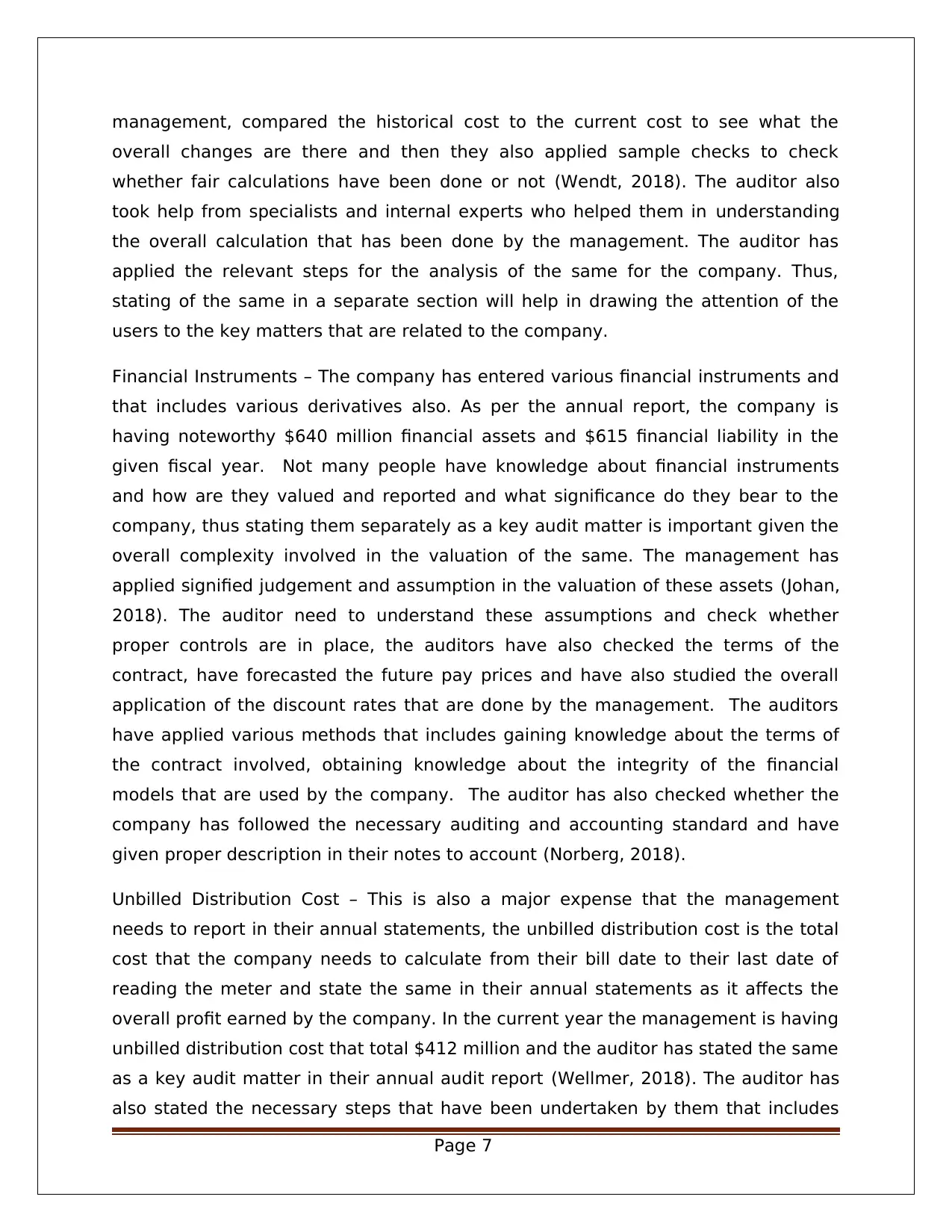
management, compared the historical cost to the current cost to see what the
overall changes are there and then they also applied sample checks to check
whether fair calculations have been done or not (Wendt, 2018). The auditor also
took help from specialists and internal experts who helped them in understanding
the overall calculation that has been done by the management. The auditor has
applied the relevant steps for the analysis of the same for the company. Thus,
stating of the same in a separate section will help in drawing the attention of the
users to the key matters that are related to the company.
Financial Instruments – The company has entered various financial instruments and
that includes various derivatives also. As per the annual report, the company is
having noteworthy $640 million financial assets and $615 financial liability in the
given fiscal year. Not many people have knowledge about financial instruments
and how are they valued and reported and what significance do they bear to the
company, thus stating them separately as a key audit matter is important given the
overall complexity involved in the valuation of the same. The management has
applied signified judgement and assumption in the valuation of these assets (Johan,
2018). The auditor need to understand these assumptions and check whether
proper controls are in place, the auditors have also checked the terms of the
contract, have forecasted the future pay prices and have also studied the overall
application of the discount rates that are done by the management. The auditors
have applied various methods that includes gaining knowledge about the terms of
the contract involved, obtaining knowledge about the integrity of the financial
models that are used by the company. The auditor has also checked whether the
company has followed the necessary auditing and accounting standard and have
given proper description in their notes to account (Norberg, 2018).
Unbilled Distribution Cost – This is also a major expense that the management
needs to report in their annual statements, the unbilled distribution cost is the total
cost that the company needs to calculate from their bill date to their last date of
reading the meter and state the same in their annual statements as it affects the
overall profit earned by the company. In the current year the management is having
unbilled distribution cost that total $412 million and the auditor has stated the same
as a key audit matter in their annual audit report (Wellmer, 2018). The auditor has
also stated the necessary steps that have been undertaken by them that includes
Page 7
overall changes are there and then they also applied sample checks to check
whether fair calculations have been done or not (Wendt, 2018). The auditor also
took help from specialists and internal experts who helped them in understanding
the overall calculation that has been done by the management. The auditor has
applied the relevant steps for the analysis of the same for the company. Thus,
stating of the same in a separate section will help in drawing the attention of the
users to the key matters that are related to the company.
Financial Instruments – The company has entered various financial instruments and
that includes various derivatives also. As per the annual report, the company is
having noteworthy $640 million financial assets and $615 financial liability in the
given fiscal year. Not many people have knowledge about financial instruments
and how are they valued and reported and what significance do they bear to the
company, thus stating them separately as a key audit matter is important given the
overall complexity involved in the valuation of the same. The management has
applied signified judgement and assumption in the valuation of these assets (Johan,
2018). The auditor need to understand these assumptions and check whether
proper controls are in place, the auditors have also checked the terms of the
contract, have forecasted the future pay prices and have also studied the overall
application of the discount rates that are done by the management. The auditors
have applied various methods that includes gaining knowledge about the terms of
the contract involved, obtaining knowledge about the integrity of the financial
models that are used by the company. The auditor has also checked whether the
company has followed the necessary auditing and accounting standard and have
given proper description in their notes to account (Norberg, 2018).
Unbilled Distribution Cost – This is also a major expense that the management
needs to report in their annual statements, the unbilled distribution cost is the total
cost that the company needs to calculate from their bill date to their last date of
reading the meter and state the same in their annual statements as it affects the
overall profit earned by the company. In the current year the management is having
unbilled distribution cost that total $412 million and the auditor has stated the same
as a key audit matter in their annual audit report (Wellmer, 2018). The auditor has
also stated the necessary steps that have been undertaken by them that includes
Page 7
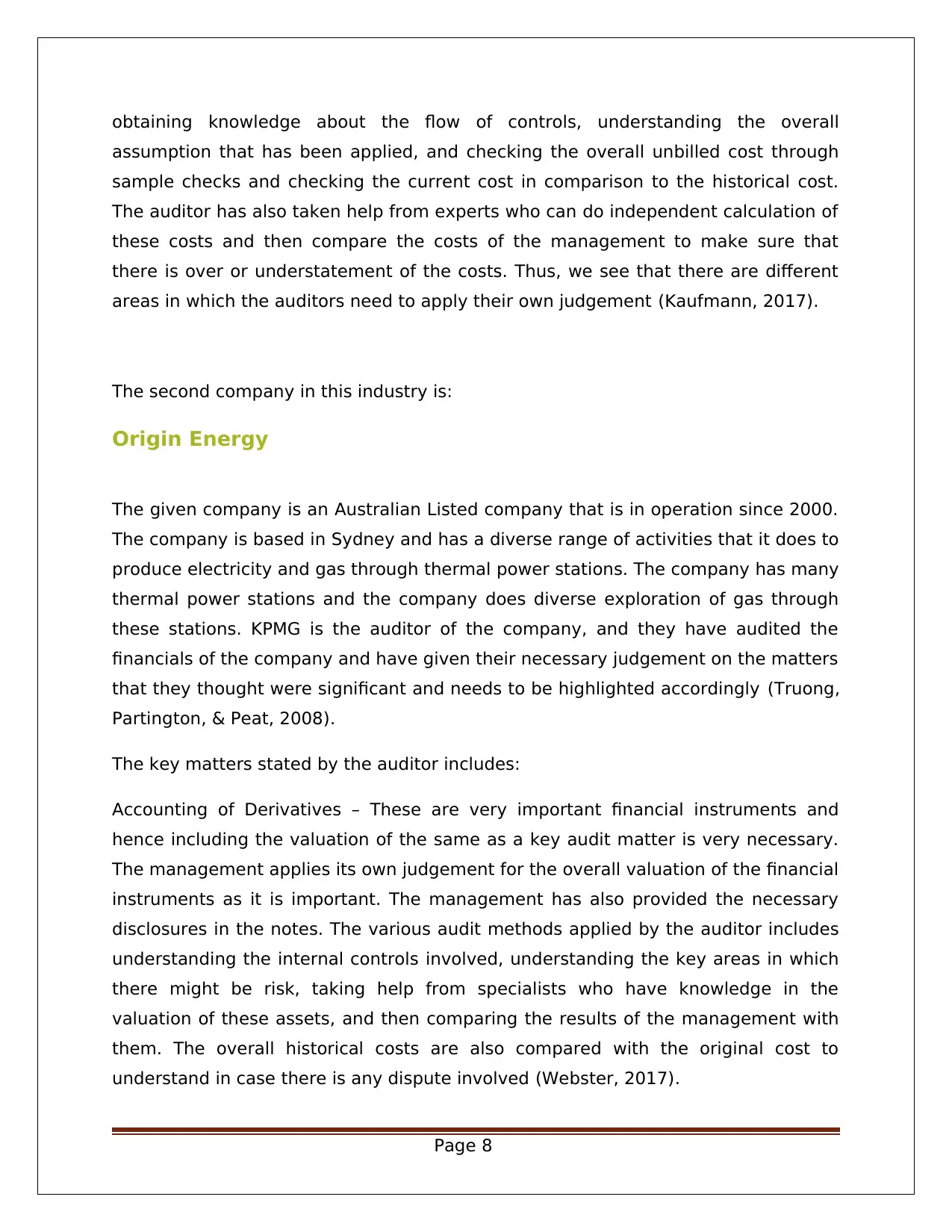
obtaining knowledge about the flow of controls, understanding the overall
assumption that has been applied, and checking the overall unbilled cost through
sample checks and checking the current cost in comparison to the historical cost.
The auditor has also taken help from experts who can do independent calculation of
these costs and then compare the costs of the management to make sure that
there is over or understatement of the costs. Thus, we see that there are different
areas in which the auditors need to apply their own judgement (Kaufmann, 2017).
The second company in this industry is:
Origin Energy
The given company is an Australian Listed company that is in operation since 2000.
The company is based in Sydney and has a diverse range of activities that it does to
produce electricity and gas through thermal power stations. The company has many
thermal power stations and the company does diverse exploration of gas through
these stations. KPMG is the auditor of the company, and they have audited the
financials of the company and have given their necessary judgement on the matters
that they thought were significant and needs to be highlighted accordingly (Truong,
Partington, & Peat, 2008).
The key matters stated by the auditor includes:
Accounting of Derivatives – These are very important financial instruments and
hence including the valuation of the same as a key audit matter is very necessary.
The management applies its own judgement for the overall valuation of the financial
instruments as it is important. The management has also provided the necessary
disclosures in the notes. The various audit methods applied by the auditor includes
understanding the internal controls involved, understanding the key areas in which
there might be risk, taking help from specialists who have knowledge in the
valuation of these assets, and then comparing the results of the management with
them. The overall historical costs are also compared with the original cost to
understand in case there is any dispute involved (Webster, 2017).
Page 8
assumption that has been applied, and checking the overall unbilled cost through
sample checks and checking the current cost in comparison to the historical cost.
The auditor has also taken help from experts who can do independent calculation of
these costs and then compare the costs of the management to make sure that
there is over or understatement of the costs. Thus, we see that there are different
areas in which the auditors need to apply their own judgement (Kaufmann, 2017).
The second company in this industry is:
Origin Energy
The given company is an Australian Listed company that is in operation since 2000.
The company is based in Sydney and has a diverse range of activities that it does to
produce electricity and gas through thermal power stations. The company has many
thermal power stations and the company does diverse exploration of gas through
these stations. KPMG is the auditor of the company, and they have audited the
financials of the company and have given their necessary judgement on the matters
that they thought were significant and needs to be highlighted accordingly (Truong,
Partington, & Peat, 2008).
The key matters stated by the auditor includes:
Accounting of Derivatives – These are very important financial instruments and
hence including the valuation of the same as a key audit matter is very necessary.
The management applies its own judgement for the overall valuation of the financial
instruments as it is important. The management has also provided the necessary
disclosures in the notes. The various audit methods applied by the auditor includes
understanding the internal controls involved, understanding the key areas in which
there might be risk, taking help from specialists who have knowledge in the
valuation of these assets, and then comparing the results of the management with
them. The overall historical costs are also compared with the original cost to
understand in case there is any dispute involved (Webster, 2017).
Page 8
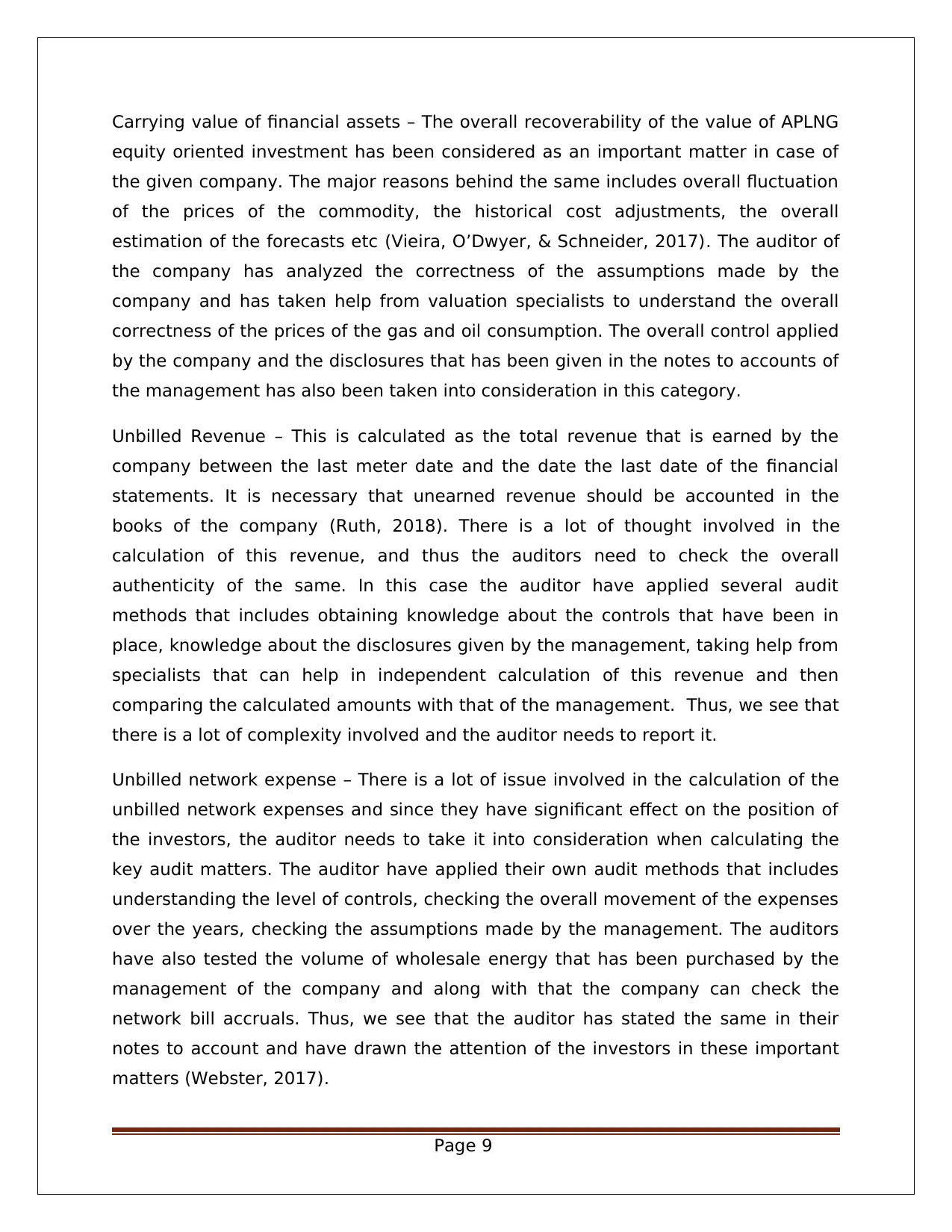
Carrying value of financial assets – The overall recoverability of the value of APLNG
equity oriented investment has been considered as an important matter in case of
the given company. The major reasons behind the same includes overall fluctuation
of the prices of the commodity, the historical cost adjustments, the overall
estimation of the forecasts etc (Vieira, O’Dwyer, & Schneider, 2017). The auditor of
the company has analyzed the correctness of the assumptions made by the
company and has taken help from valuation specialists to understand the overall
correctness of the prices of the gas and oil consumption. The overall control applied
by the company and the disclosures that has been given in the notes to accounts of
the management has also been taken into consideration in this category.
Unbilled Revenue – This is calculated as the total revenue that is earned by the
company between the last meter date and the date the last date of the financial
statements. It is necessary that unearned revenue should be accounted in the
books of the company (Ruth, 2018). There is a lot of thought involved in the
calculation of this revenue, and thus the auditors need to check the overall
authenticity of the same. In this case the auditor have applied several audit
methods that includes obtaining knowledge about the controls that have been in
place, knowledge about the disclosures given by the management, taking help from
specialists that can help in independent calculation of this revenue and then
comparing the calculated amounts with that of the management. Thus, we see that
there is a lot of complexity involved and the auditor needs to report it.
Unbilled network expense – There is a lot of issue involved in the calculation of the
unbilled network expenses and since they have significant effect on the position of
the investors, the auditor needs to take it into consideration when calculating the
key audit matters. The auditor have applied their own audit methods that includes
understanding the level of controls, checking the overall movement of the expenses
over the years, checking the assumptions made by the management. The auditors
have also tested the volume of wholesale energy that has been purchased by the
management of the company and along with that the company can check the
network bill accruals. Thus, we see that the auditor has stated the same in their
notes to account and have drawn the attention of the investors in these important
matters (Webster, 2017).
Page 9
equity oriented investment has been considered as an important matter in case of
the given company. The major reasons behind the same includes overall fluctuation
of the prices of the commodity, the historical cost adjustments, the overall
estimation of the forecasts etc (Vieira, O’Dwyer, & Schneider, 2017). The auditor of
the company has analyzed the correctness of the assumptions made by the
company and has taken help from valuation specialists to understand the overall
correctness of the prices of the gas and oil consumption. The overall control applied
by the company and the disclosures that has been given in the notes to accounts of
the management has also been taken into consideration in this category.
Unbilled Revenue – This is calculated as the total revenue that is earned by the
company between the last meter date and the date the last date of the financial
statements. It is necessary that unearned revenue should be accounted in the
books of the company (Ruth, 2018). There is a lot of thought involved in the
calculation of this revenue, and thus the auditors need to check the overall
authenticity of the same. In this case the auditor have applied several audit
methods that includes obtaining knowledge about the controls that have been in
place, knowledge about the disclosures given by the management, taking help from
specialists that can help in independent calculation of this revenue and then
comparing the calculated amounts with that of the management. Thus, we see that
there is a lot of complexity involved and the auditor needs to report it.
Unbilled network expense – There is a lot of issue involved in the calculation of the
unbilled network expenses and since they have significant effect on the position of
the investors, the auditor needs to take it into consideration when calculating the
key audit matters. The auditor have applied their own audit methods that includes
understanding the level of controls, checking the overall movement of the expenses
over the years, checking the assumptions made by the management. The auditors
have also tested the volume of wholesale energy that has been purchased by the
management of the company and along with that the company can check the
network bill accruals. Thus, we see that the auditor has stated the same in their
notes to account and have drawn the attention of the investors in these important
matters (Webster, 2017).
Page 9
Secure Best Marks with AI Grader
Need help grading? Try our AI Grader for instant feedback on your assignments.

Conclusion
Based on the overall judgment it can be said that the auditor of both the same have
followed the auditing standard very properly and have made significant disclosures
in the financials of the company. All they important matters have been stated
significantly by the auditors and that has also helped in bringing notice to the
stakeholders. The stakeholders can see this section of the key audit matters and
draw attention on such matters that affect the overall return that the stakeholder
can generate from the given company. The auditors have presented all the
information in the best ways possible and have also stated the key steps that they
have taken to check the overall correctness of the financial statements.
ABILENE OIL AND GAS LIMITED
Abilene oil and gas limited is a company that is mostly engaged in oil exploration,
increasing the number of drilling locations and adding various acreage in the region.
The company is an energy based company that is listed on the Australian Stock
Exchange. The audit report of the company has been analyzed to state the key
matters that have been mentioned by the auditors.
The auditor of the company is Grant Thornton and they have stated this in their key
audit reports.
Investment in associates - The Company is having investment in subsidiaries that is
accounted under the equity method. The management has applied their judgement
whether there is any impairment triggers that they need to take care of. The auditor
have applied their own judgement to under proper controls are in place or not,
assessing the overall appropriateness of the valuation done by the management
among others. The auditors also took help from valuation specialists to understand
whether the efforts of the management were correct or not.
The auditor has also stated other key audit matters which includes exploration and
evaluation of the assets.
Page 10
Based on the overall judgment it can be said that the auditor of both the same have
followed the auditing standard very properly and have made significant disclosures
in the financials of the company. All they important matters have been stated
significantly by the auditors and that has also helped in bringing notice to the
stakeholders. The stakeholders can see this section of the key audit matters and
draw attention on such matters that affect the overall return that the stakeholder
can generate from the given company. The auditors have presented all the
information in the best ways possible and have also stated the key steps that they
have taken to check the overall correctness of the financial statements.
ABILENE OIL AND GAS LIMITED
Abilene oil and gas limited is a company that is mostly engaged in oil exploration,
increasing the number of drilling locations and adding various acreage in the region.
The company is an energy based company that is listed on the Australian Stock
Exchange. The audit report of the company has been analyzed to state the key
matters that have been mentioned by the auditors.
The auditor of the company is Grant Thornton and they have stated this in their key
audit reports.
Investment in associates - The Company is having investment in subsidiaries that is
accounted under the equity method. The management has applied their judgement
whether there is any impairment triggers that they need to take care of. The auditor
have applied their own judgement to under proper controls are in place or not,
assessing the overall appropriateness of the valuation done by the management
among others. The auditors also took help from valuation specialists to understand
whether the efforts of the management were correct or not.
The auditor has also stated other key audit matters which includes exploration and
evaluation of the assets.
Page 10

Page 11
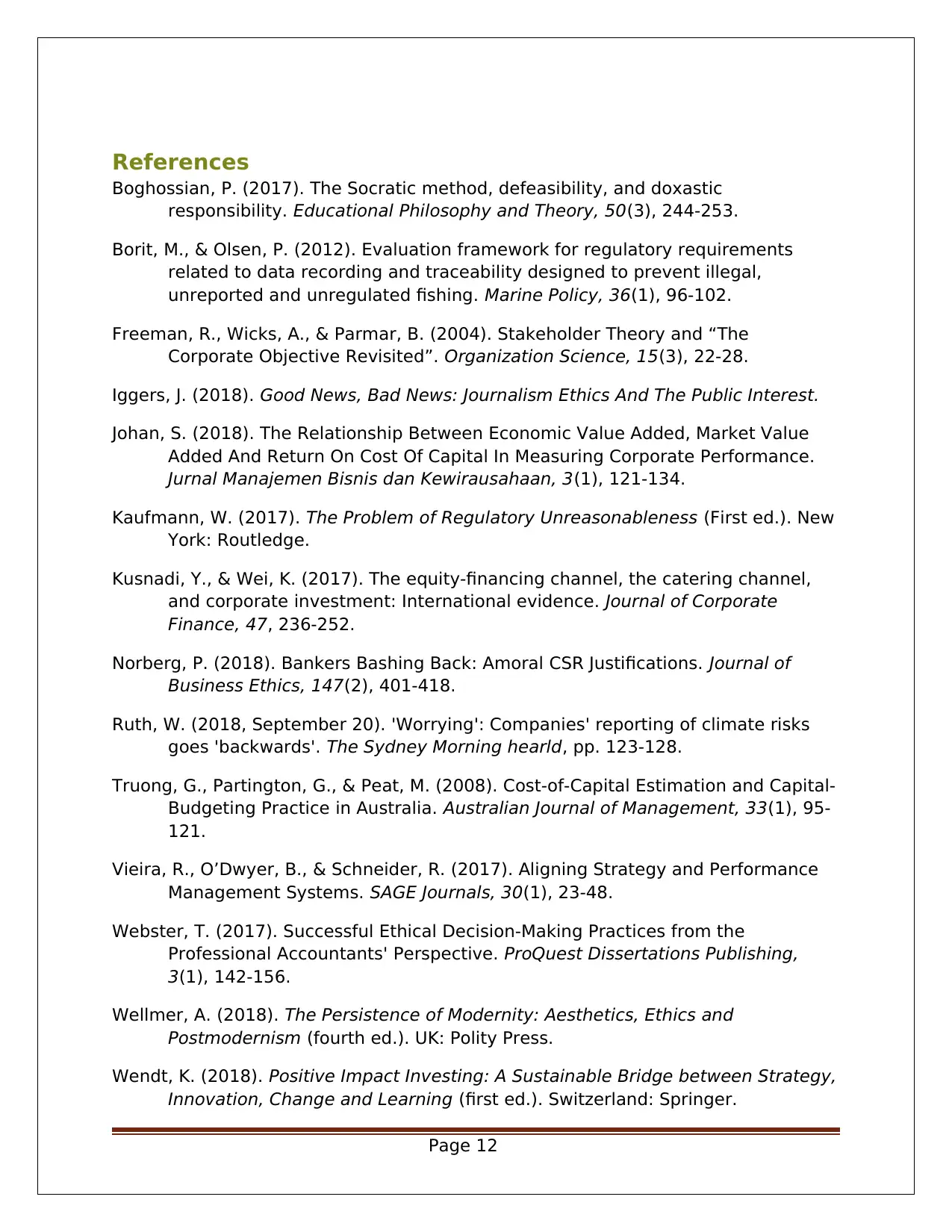
References
Boghossian, P. (2017). The Socratic method, defeasibility, and doxastic
responsibility. Educational Philosophy and Theory, 50(3), 244-253.
Borit, M., & Olsen, P. (2012). Evaluation framework for regulatory requirements
related to data recording and traceability designed to prevent illegal,
unreported and unregulated fishing. Marine Policy, 36(1), 96-102.
Freeman, R., Wicks, A., & Parmar, B. (2004). Stakeholder Theory and “The
Corporate Objective Revisited”. Organization Science, 15(3), 22-28.
Iggers, J. (2018). Good News, Bad News: Journalism Ethics And The Public Interest.
Johan, S. (2018). The Relationship Between Economic Value Added, Market Value
Added And Return On Cost Of Capital In Measuring Corporate Performance.
Jurnal Manajemen Bisnis dan Kewirausahaan, 3(1), 121-134.
Kaufmann, W. (2017). The Problem of Regulatory Unreasonableness (First ed.). New
York: Routledge.
Kusnadi, Y., & Wei, K. (2017). The equity-financing channel, the catering channel,
and corporate investment: International evidence. Journal of Corporate
Finance, 47, 236-252.
Norberg, P. (2018). Bankers Bashing Back: Amoral CSR Justifications. Journal of
Business Ethics, 147(2), 401-418.
Ruth, W. (2018, September 20). 'Worrying': Companies' reporting of climate risks
goes 'backwards'. The Sydney Morning hearld, pp. 123-128.
Truong, G., Partington, G., & Peat, M. (2008). Cost-of-Capital Estimation and Capital-
Budgeting Practice in Australia. Australian Journal of Management, 33(1), 95-
121.
Vieira, R., O’Dwyer, B., & Schneider, R. (2017). Aligning Strategy and Performance
Management Systems. SAGE Journals, 30(1), 23-48.
Webster, T. (2017). Successful Ethical Decision-Making Practices from the
Professional Accountants' Perspective. ProQuest Dissertations Publishing,
3(1), 142-156.
Wellmer, A. (2018). The Persistence of Modernity: Aesthetics, Ethics and
Postmodernism (fourth ed.). UK: Polity Press.
Wendt, K. (2018). Positive Impact Investing: A Sustainable Bridge between Strategy,
Innovation, Change and Learning (first ed.). Switzerland: Springer.
Page 12
Boghossian, P. (2017). The Socratic method, defeasibility, and doxastic
responsibility. Educational Philosophy and Theory, 50(3), 244-253.
Borit, M., & Olsen, P. (2012). Evaluation framework for regulatory requirements
related to data recording and traceability designed to prevent illegal,
unreported and unregulated fishing. Marine Policy, 36(1), 96-102.
Freeman, R., Wicks, A., & Parmar, B. (2004). Stakeholder Theory and “The
Corporate Objective Revisited”. Organization Science, 15(3), 22-28.
Iggers, J. (2018). Good News, Bad News: Journalism Ethics And The Public Interest.
Johan, S. (2018). The Relationship Between Economic Value Added, Market Value
Added And Return On Cost Of Capital In Measuring Corporate Performance.
Jurnal Manajemen Bisnis dan Kewirausahaan, 3(1), 121-134.
Kaufmann, W. (2017). The Problem of Regulatory Unreasonableness (First ed.). New
York: Routledge.
Kusnadi, Y., & Wei, K. (2017). The equity-financing channel, the catering channel,
and corporate investment: International evidence. Journal of Corporate
Finance, 47, 236-252.
Norberg, P. (2018). Bankers Bashing Back: Amoral CSR Justifications. Journal of
Business Ethics, 147(2), 401-418.
Ruth, W. (2018, September 20). 'Worrying': Companies' reporting of climate risks
goes 'backwards'. The Sydney Morning hearld, pp. 123-128.
Truong, G., Partington, G., & Peat, M. (2008). Cost-of-Capital Estimation and Capital-
Budgeting Practice in Australia. Australian Journal of Management, 33(1), 95-
121.
Vieira, R., O’Dwyer, B., & Schneider, R. (2017). Aligning Strategy and Performance
Management Systems. SAGE Journals, 30(1), 23-48.
Webster, T. (2017). Successful Ethical Decision-Making Practices from the
Professional Accountants' Perspective. ProQuest Dissertations Publishing,
3(1), 142-156.
Wellmer, A. (2018). The Persistence of Modernity: Aesthetics, Ethics and
Postmodernism (fourth ed.). UK: Polity Press.
Wendt, K. (2018). Positive Impact Investing: A Sustainable Bridge between Strategy,
Innovation, Change and Learning (first ed.). Switzerland: Springer.
Page 12
Paraphrase This Document
Need a fresh take? Get an instant paraphrase of this document with our AI Paraphraser

Page 13
1 out of 14
Related Documents
Your All-in-One AI-Powered Toolkit for Academic Success.
+13062052269
info@desklib.com
Available 24*7 on WhatsApp / Email
![[object Object]](/_next/static/media/star-bottom.7253800d.svg)
Unlock your academic potential
© 2024 | Zucol Services PVT LTD | All rights reserved.





